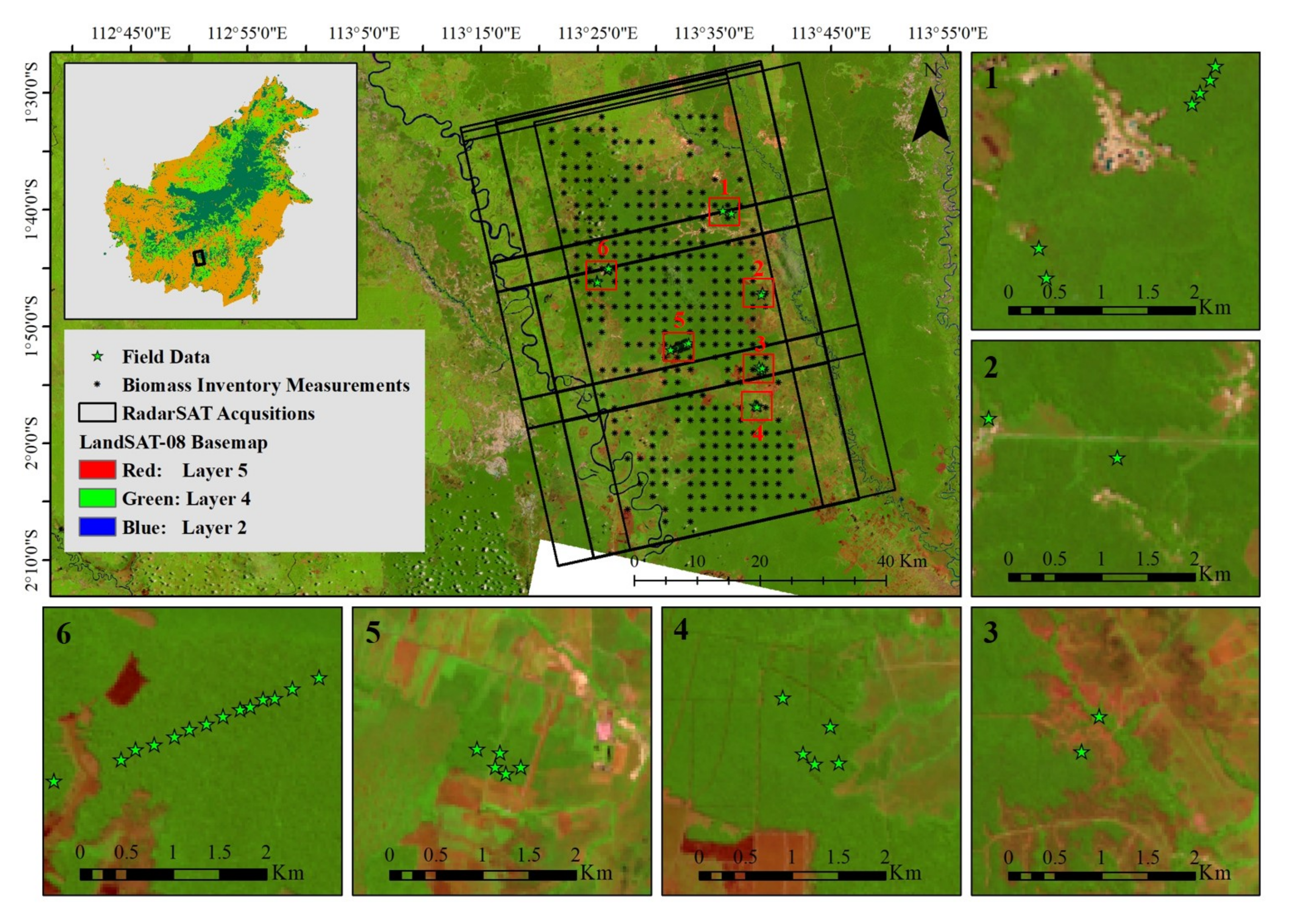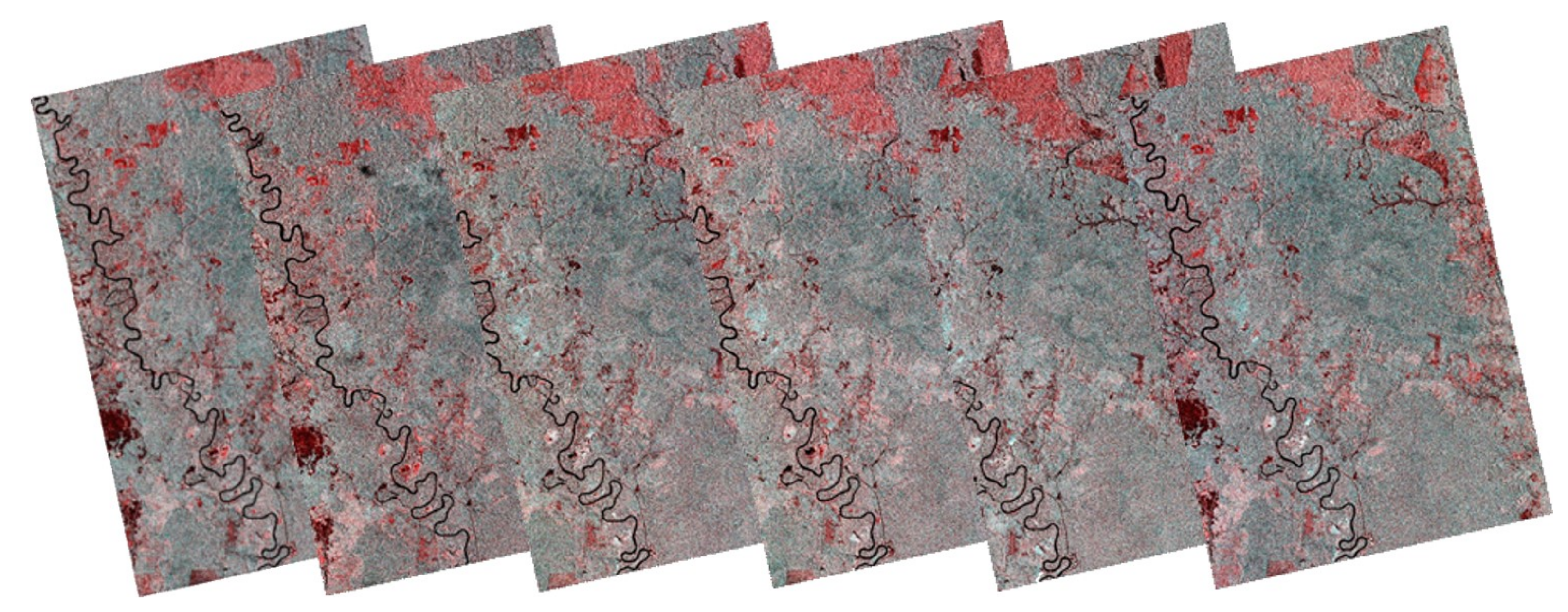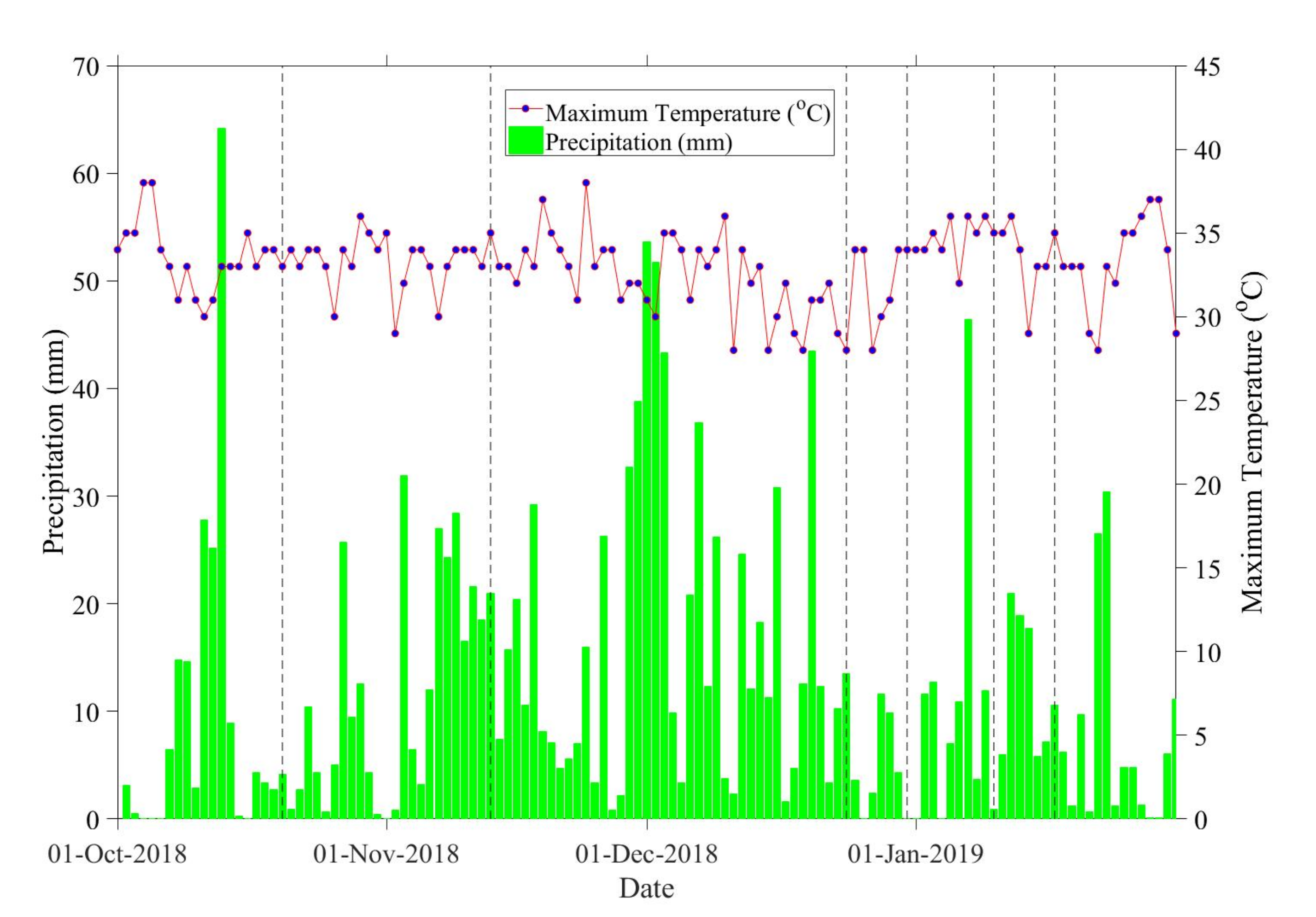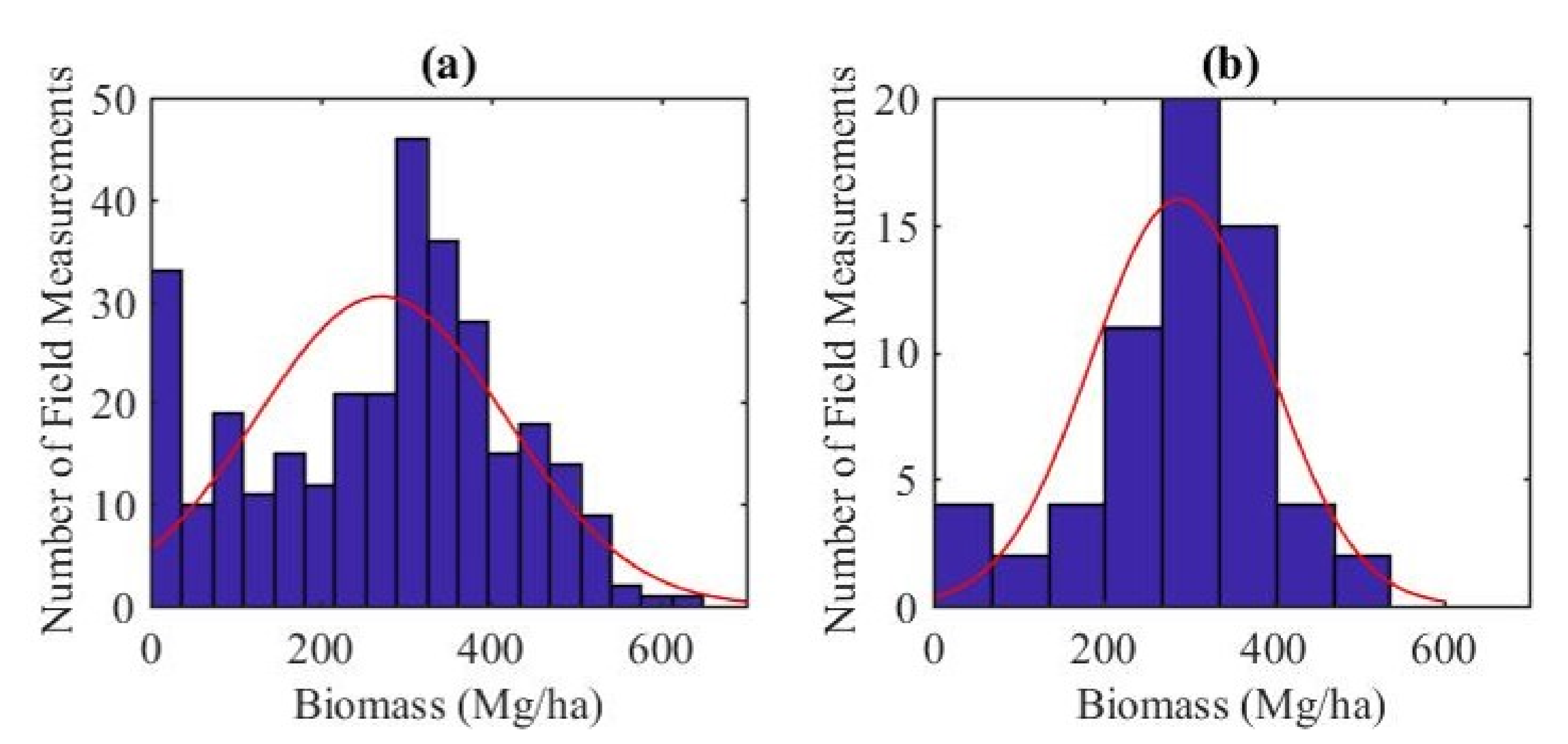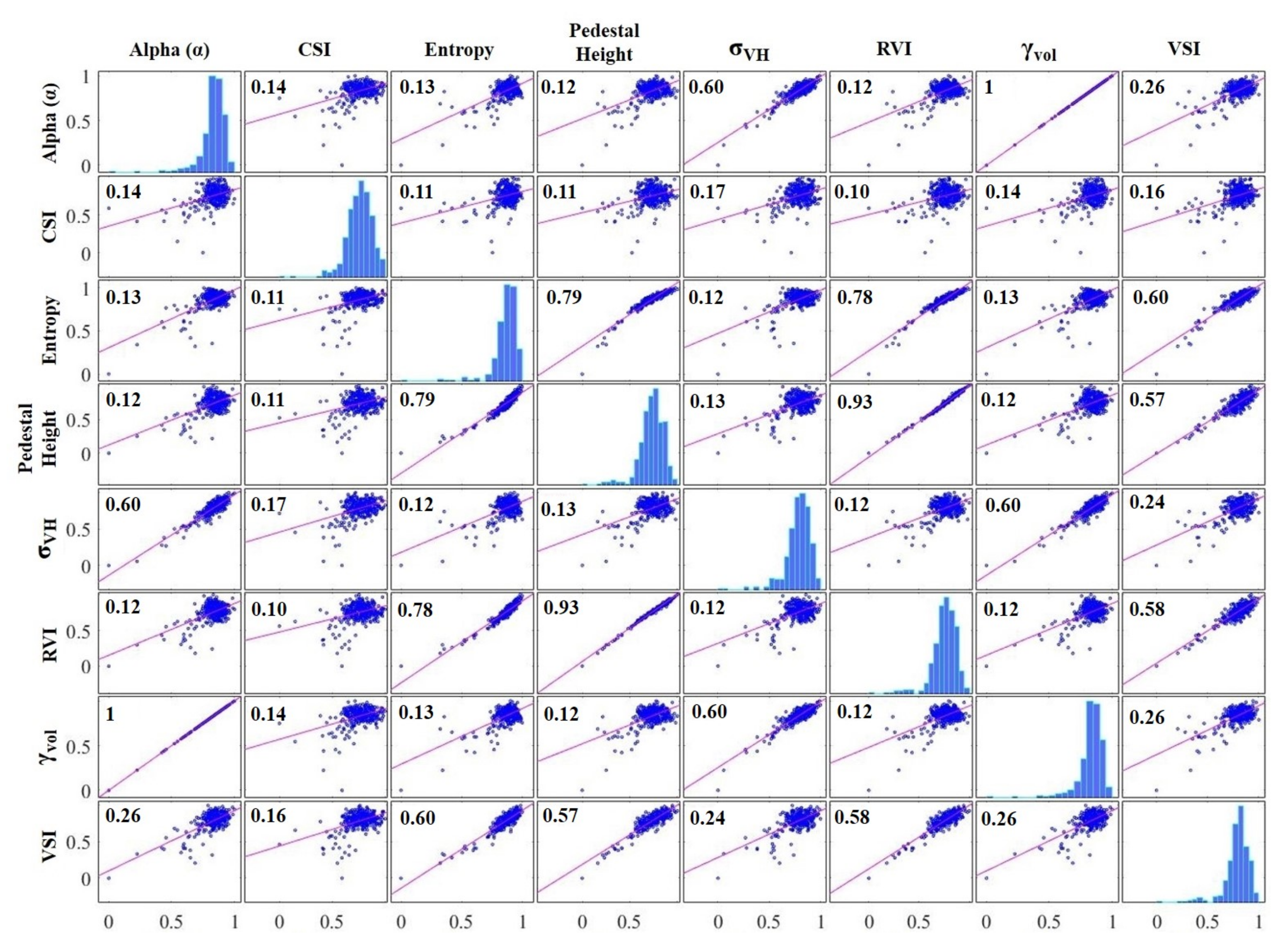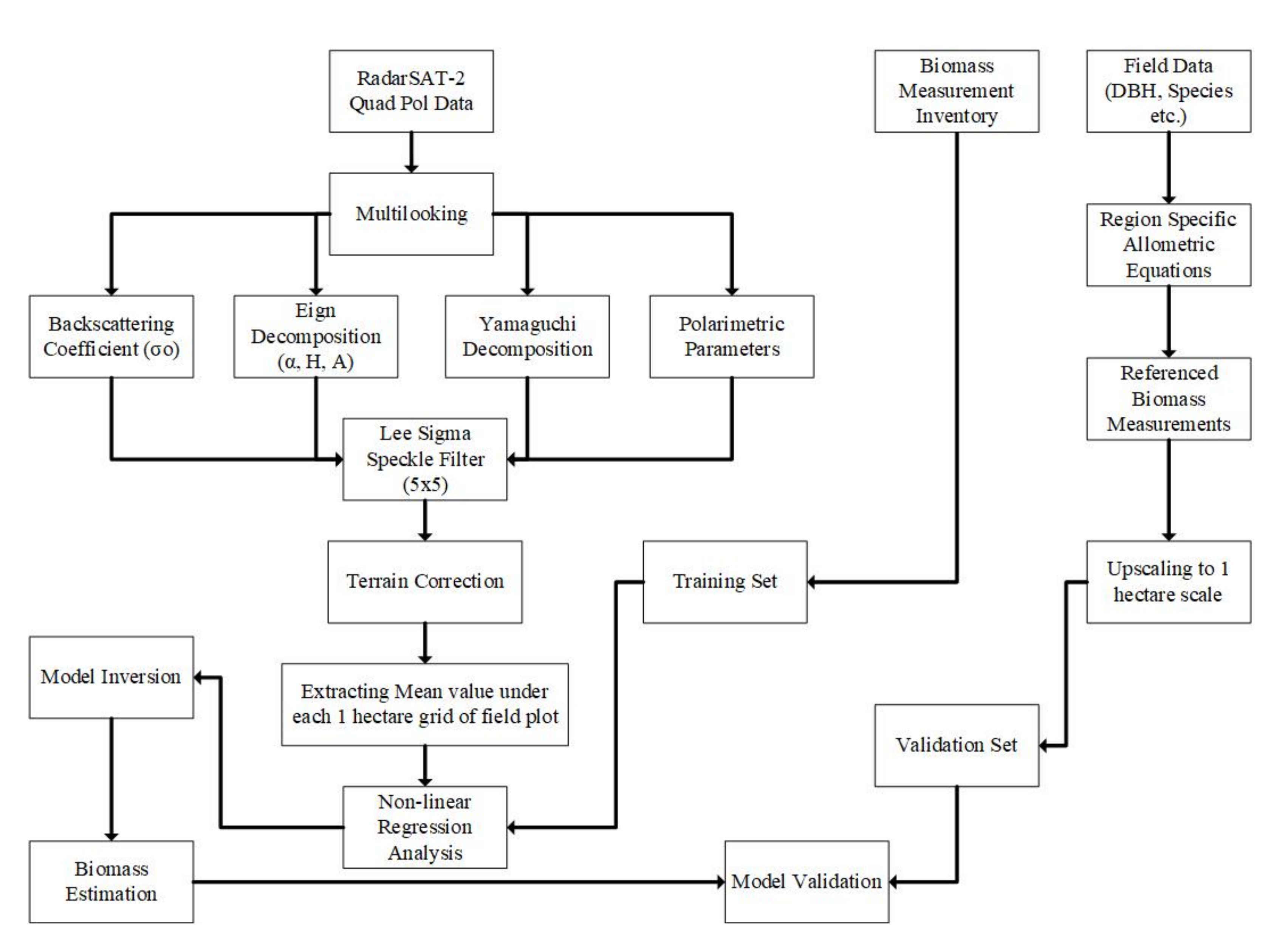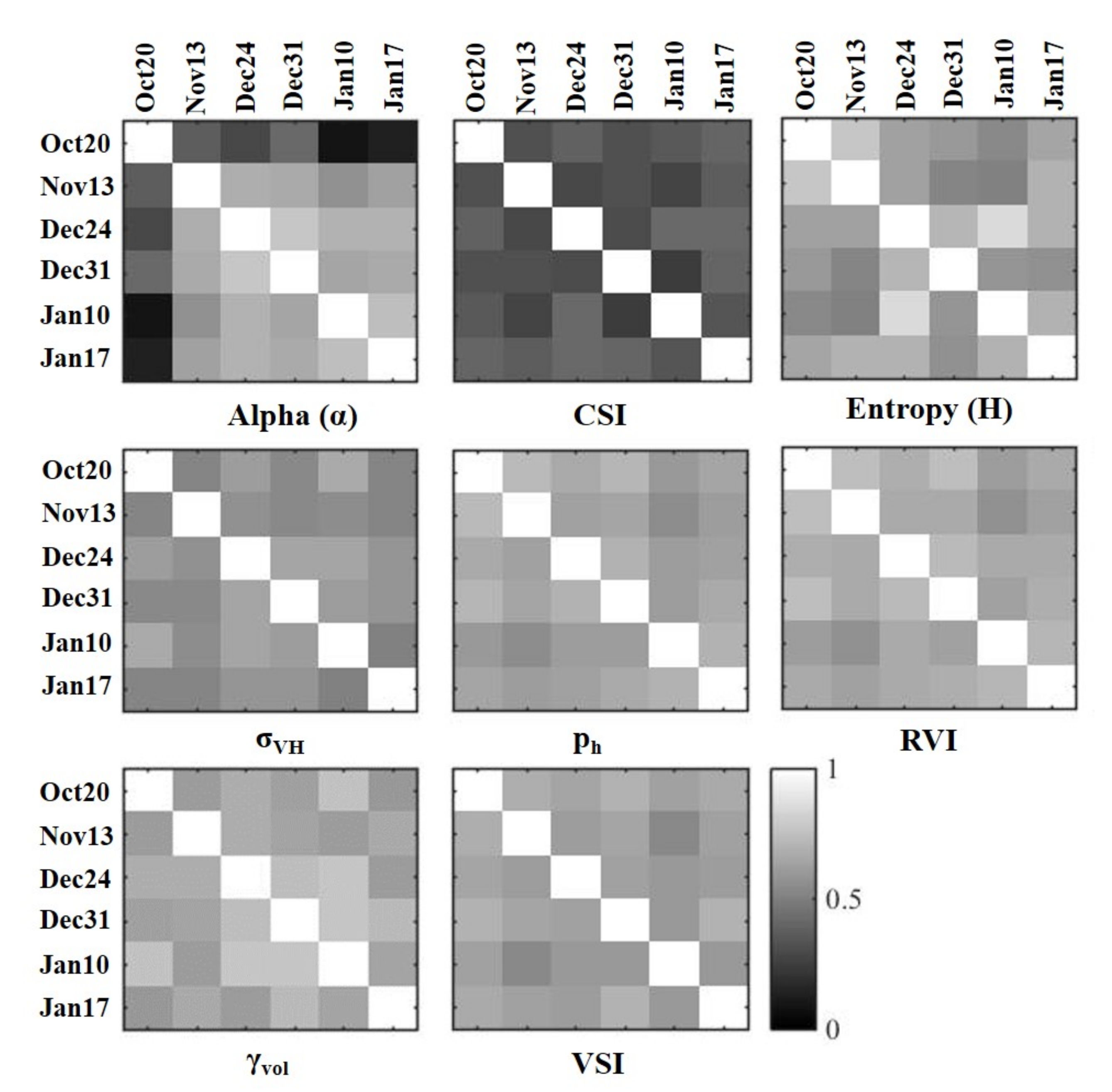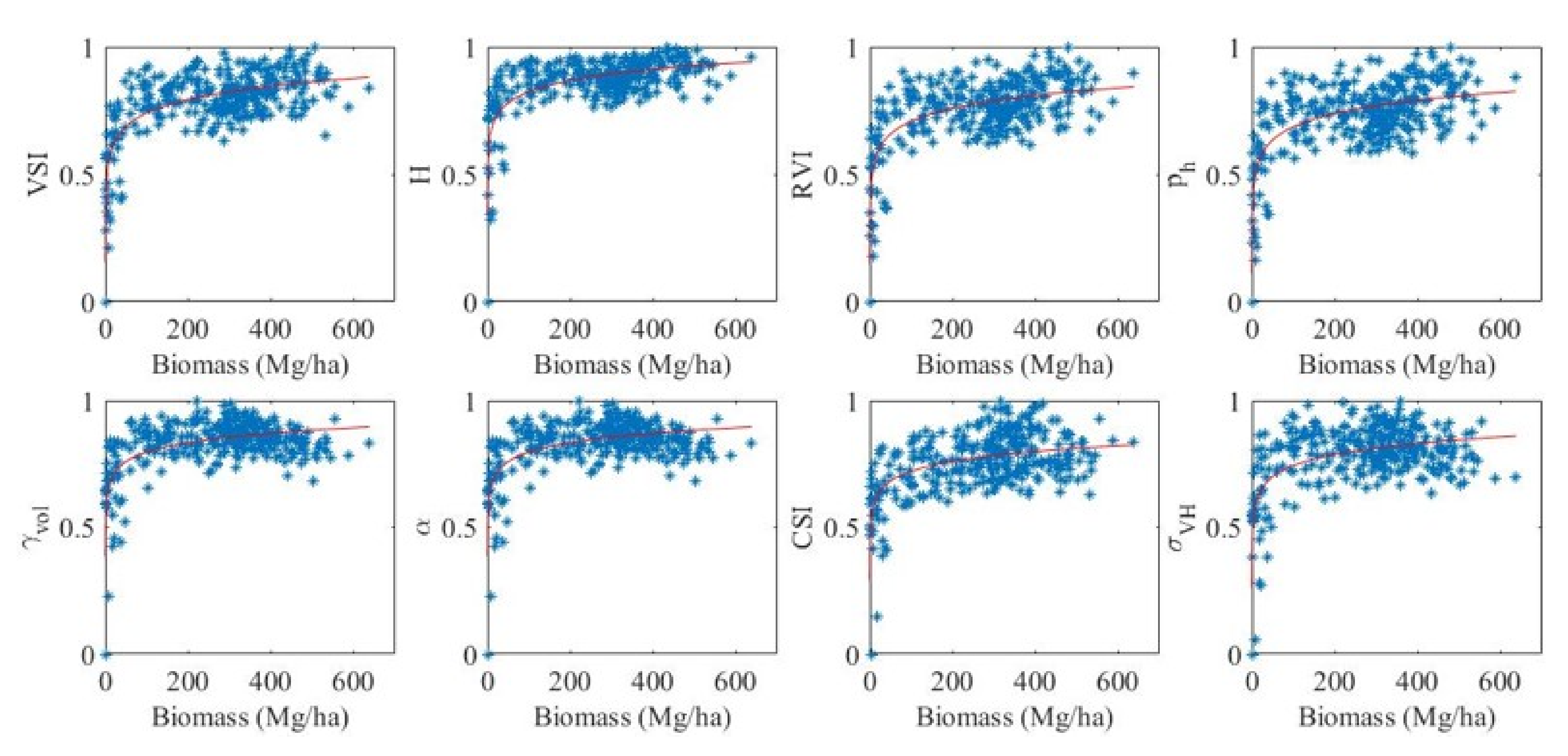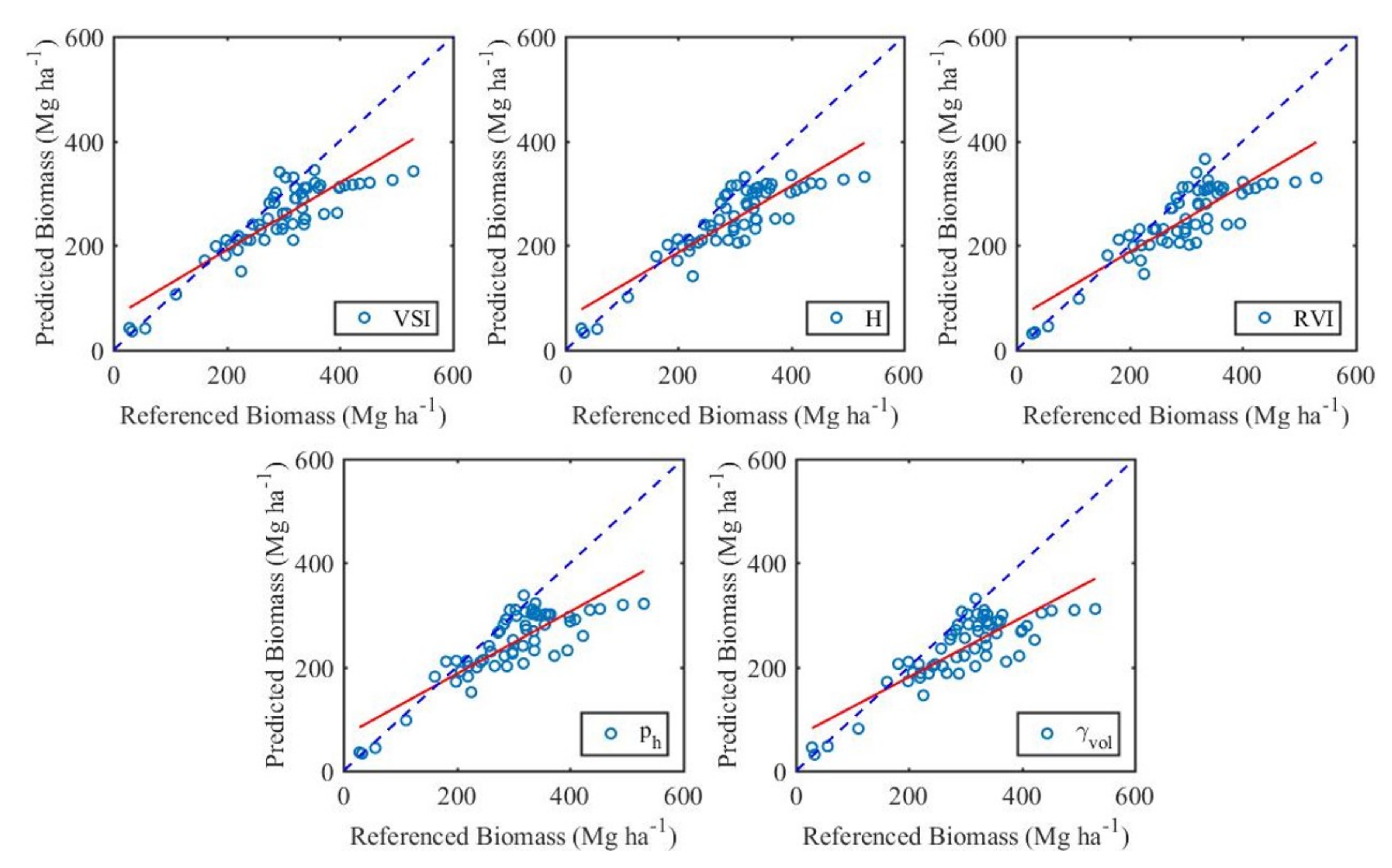1. Introduction
Aboveground biomass is an important biophysical describing all living biomass above the soil that includes stems, branches, leaves, barks, seeds and foliage in terrestrial ecosystems [
1]. It plays an important role in maintaining the carbon cycle by removing CO
2 from the atmosphere by the process of photosynthesis and storing it in the components of trees. Due to rapid urbanization, forest regions are deforested and degraded especially in developing countries. The tropical rainforests are the most significant carbon reservoir. They are home to gigantic trees, world-famous plants, birds and a variety of fascinating mammals. Around 80% of the world’s documented species can be found in tropical rainforests, although they cover only 6% of the Earth’s land surface. Furthermore, tropical rainforests have the largest living biomass and home to the highest rate of terrestrial biodiversity However they are the most endangered habitat and vulnerable to deforestation and degradation. Annual deforestation rate of rainforests is alarmingly high which is about 140,000 km
2 [
2]. Mostly rainforests are deforested by logging companies for timber and local community for farming. Among the most endangered rainforests are the south–east Asian rainforest especially in the Kalimantan Island is facing deforestation and degradation at an alarming rate especially due to a rapid increase in human population [
3]. Due to deforestation, degradation and forest burning, the stored CO
2 can return back to the atmosphere and can alter atmospheric composition which can result in climate change and global warming [
4].
Cost-effective assessment of the forest biomass is vital for effective forest industry, sustainable forest management and resource planning [
5]. Traditional practices involve extensive fieldwork with substantial human resources in the field, however, such practices are not sustainable for developing countries like Indonesia. Recently remote sensing is being extensively used for forest studies [
6,
7,
8], however, incorporating field-based forest biophysical parameters increases the estimation accuracy of forest biophysical parameters using remote sensing data [
9,
10,
11,
12,
13]. Researchers attempted to estimate forest AGB using optical, SAR and lidar data. Each of these have the potential to estimate different characteristics of forest structure. Application of optical remote sensing is very limited to low stand biomass regions. However, high-resolution optical data provide estimation of biophysical parameters at stand level [
14]. However, Synthetic Aperture Radar (SAR) and lidar are proven to be more effective over the medium to high stand level biomass [
15]. Many researchers used optical remote sensing data ranging from medium resolutions to very high resolution that includes: Landsat, Sentinal, QuickBird and WorldView-2 for forest aboveground biomass estimation [
16,
17,
18,
19,
20]. As tropical regions are mostly covered with clouds, the applications of optical remote sensing data is limited over the tropical area. However, SAR provides unique penetration capability through clouds, which allow all weather condition monitoring capability over tropical regions. Remote sensing of forest structure and biomass with SAR bear significant potential for mapping and understanding of ecological processes [
21,
22,
23]. SAR can provide significant information about forest structure depending on microwave (X-, C-, L-, P-) band used for image acquisition. Scattering from X-band image mostly contain information about leaves and small branches, scattering from C-band image provide information about main branches, L-band have a penetration capability until stem of the tree, however, under ideal conditions P-band can penetrate until soil and main roots.
Because of it’s unique penetration capability, SAR is very suitable for forest biophysical parameter estimation over a heterogeneous environment like natural forest. Polarimetric SAR (PolSAR) is also considered to be an alternative with active development particularly in forest applications. In this paper, PolSAR term will be used frequently for full polarimetric SAR or quad pol SAR data. PolSAR-based forest biophysical parameters estimation is an active research area nowadays where decomposition based polarimetric parameters are being used in synergy with field based reference measurements for forest biomass estimation [
24,
25,
26,
27]. PolSAR-based AGB estimation at higher level of forest biomass experiences saturation of PolSAR signal and it’s well documented limitation of this technique [
5,
28,
29]. As natural forest is perfectly random in nature, polarimetric parameters describing randomness of the target could be significantly correlated with forest biophysical parameters. Few attempts were made to exploit these polarimetric parameters to estimate forest parameters [
30], however, a comprehensive analysis of polarimetric parameters and it’s temporal consistency using time-series C-band PolSAR data is not performed yet. This study focuses on estimating aboveground biomass using polarimetric parameters estimated from C-band RadarSAT-2 image. Furthermore, consistency of these polarimetric parameters was investigated for its multi-temporal behaviour for AGB estimation.
The paper is organized as follows.
Section 2 mainly focused on description of study area, PolSAR data used in this study, Ancillary Data used, referenced data used for modeling biomass as a function of polarimetric parameters, main PolSAR concepts with related description, preprocessing of PolSAR data and methodological framework adopted in this research. In
Section 3, the key analysis was preformed and discussed. In
Section 4, study is concluded and future directions are potentials are listed.
3. Results and Discussions
First of all, temporal consistency and inter-dependency of polarimetric parameters and their suitability for AGB estimation is discussed. We also described the results of regression between polarimetric parameters and reference biomass measurements. Next, the validation results are described in detail.
3.1. Temporal Dependence of Polarimetric Parameters
As PolSAR images were acquired under different weather conditions (see
Figure 3). It is important analyze the impact caused by different weather conditions. For this, the PolSAR parameters extracted from temporal images were evaluated in terms of their temporal consistency, inter-dependence and suitability for forest aboveground biomass estimation across rainy and dry conditions.
Figure 7 shows the correlation graph of each polarimetric parameter for all PolSAR acquisitions. It can be seen that
and CSI are not temporally correlated, however H,
,
, RVI,
and VSI are temporally correlated at scale of moderate to high. Based on this temporal correlation, it is expected that the AGB vs polariemtric parameters modeling results will be temporally consistent except for
and CSI. The suitability of selected polarimetric parameters (listed in
Table 3) for AGB estimation can be validated by modeling referenced AGB vs. polarimetric parameters using regression. For this, all selected polarimetric parameters (listed in
Table 3) were chosen for further analysis.
3.2. Regression Analysis—Modeling AGB vs. Polarimetric Parameters
Regression results for AGB vs. polarimetric parameters for 31 December 2018 acquisition is shown in
Figure 8. Similarly, regression results for selected polarimetric parameters for all PolSAR acquisitions are listed in
Table 4. As it can be seen from the
Figure 8, all polarimetric parameters were normalized between 0 and 1. This makes it easy to compare results from different polarimetric parameters having a different dynamic range.
It can be seen from
Figure 8; VSI, H, RVI,
, and
are significantly correlated with referenced biomass measurements. Similarly, CSI and
are moderately correlated with referenced biomass measurements. Similar consistent results were found for other PolSAR acquisitions (see
Table 4). Similarly it can be seen from
Table 4; regression results for 13 November 2018 acquisition are least correlated if compared to other acquisitions. This can be easily correlated with moist weather conditions during acquisition (see
Figure 3). Among selected polarimetric parameters, VSI was found to be the most correlated with
ranging from 0.45 (under moist conditions) to 0.62 (under dry conditions). Similarly,
found the least correlated with
ranging from 0.27 (under moist conditions) to 0.42 (under dry conditions). Regression results for 24 December 2018 acquisition are also moderately affected by moist conditions caused by rainfall few days before acquisition. The regression results for all selected variables are temporally consistent except of those affected by moist conditions caused by heavy precipitation.
As PolSAR-based AGB estimation at a higher level of forest biomass experiences saturation of PolSAR signal [
5,
28,
29], in this study SAR signal saturation was observed mainly at stand level 300 Mg ha
−1. However, for few polarimetric parameters e.g., RVI,
, and CSI saturation was observed at stand level 400 Mg ha
−1.
3.3. Model Validation—Reference Biomass vs Observed Biomass
Based on regression analysis, models for VSI, H, RVI, and are selected for biomass mapping. To do so, these models were inverted and from resultant models, the AGB of study site was estimated.
To get a more realistic outcome, a low pass filter was applied to get relatively smooth AGB maps. Resultant biomass maps were validated using validation set (field based referenced biomass measurements). Validation results are shown in
Figure 9. The resultant
and
are summarized in
Table 5.
Validation results were found to be very promising with
ranging from 0.77 (under dry conditions) to 0.63 (under moist conditions) and
ranging from 34.43 Mg ha
−1 to 35.82 Mg ha
−1 for VSI. Similarly, H, RVI,
and
validations results are also significant with
ranging from 0.75–0.61, 0.72–0.60, 0.72–0.64, 0.69–0.55 and
ranging from 35.12–44.44 Mg ha
−1, 38.49–47.73 Mg ha
−1, 37.35–51.84 Mg ha
−1, 37.53–54.45 Mg ha
−1 respectively during dry and wet conditions. These results are consistent with other published research for forest AGB estimation [
47,
48]. However it can be seen from
Figure 9, the estimated AGB is lower than referenced AGB. As C-band mostly interacts with leaves, main branches and under perfectly dry conditions can penetrate to the stem of tree, hence C-band is good to estimate AGB over low biomass regions.
3.4. Limitations
In this research, forest AGB was accurately estimated with the following limitations:
Referenced biomass data collected through the field is not uniformally distributed throughout the study area. With more field data that are uniformally distributed throughput the study site cover major tree species can comprehensive understanding of true biomass conditions. However it is extremely difficult due to existence of wild-life.
As region specific tree species allometric equations are not available for tree species in study site. Generic region specific allometric was used to calculate AGB using field data. Species specific allometric can give more accurate AGB estimates.
As C-band is mostly sensitive to leaves and main branches, more precise AGB estimation can be done by developing synergy of polarimetric parameters extracted from C- and L-band PolSAR data.
4. Conclusions
This study presents tropical peatland forest biomass estimation using polarimetric parameters extracted from RadarSAT-2 images. Polarimetric parameters includes backscattering coefficient (), eign-decomposition parameters (H, ), Yamaguchi decomposition parameters () and polarimetric indices (VSI, RVI, , CSI) were used to modeled AGB. A detailed methodology for pro-processing of PolSAR images and AGB modeling is presented in this paper. Non-linear regression was used to model AGB as a function of polarimetric parameters. The regression result shows significant correlation between polarimetric parameters and referenced AGB. Selected regression models based on polarimetric parameters (VSI, H, RVI, , ) were further used to generate biomass maps. Resultant biomass maps were validated with strong correlated was found between referenced AGB and predicted AGB with ranging from 0.77 to 0.58 ranging from 33.21 Mg ha−1 to 37.53 under dry conditions, ranging from 0.63 to 0.55 and ranging from 41.44 to 54.45 under moist conditions.
PolSAR images acquired under perfectly dry conditions perform better than the ones acquired under moist conditions. A saturation point was observed at 300 Mg ha−1 for VSI, H, , and . However, the saturation point for models developed using RVI, , CSI was observed at 400 Mg ha−1. The selected models also shown temporally consistent behavior.
